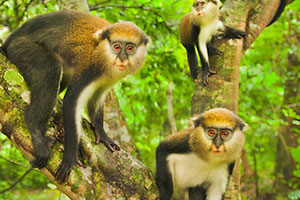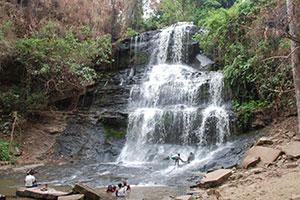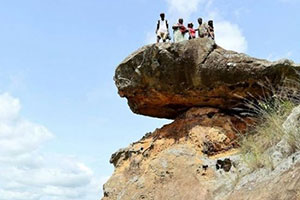Tour Packages - Brong Ahafo Region Tours

Boabeng Fiema Monkeys Sanctuary

Kintampo Water Falls

Kristo Buase Monastery

Tanoboase Tano Sacred Grove
Visit will include
- - Boabeng Fiema Monkey Sanctuary
- - Kintampo Waterfalls
- - Buoyem Caves & Bats Colony
- - Tano Boase Sacred Grove
- – Fuller Falls
- – Bono Manso Slave Market
- – Forikrom Boten Shrine & Caves
- – Nchiraa Waterfalls
- – Duasiman Monkey Sanctuary
- – Bui National Park
- – Hani Archaeological Site
- – Bui Dam
- – Busia Mausoleum
- – River Tano Sacred Fish
- – Nwoase Ostrich Farm
- – Asumura, White Necked Rock Fowl Conservation
- – Kristo Boase Monastery
- – Adekyen
Sample Itinerary
- (10 Days / 9 Nights)
Day 1. Arrival in Ghana.
Day 2. Travel to Brong Ahafo
Day 3. Kintampo Waterfalls
Day 4. Tano Boase Sacred Grove
Day 5. Nchiraa Waterfalls
Day 6. Duasidan Monkey Sanctuary
Day 7. Fuller Falls
Day 8. Bond Manso Slave Market
Day 9. Shopping
Day 10. Free Day & Departure in the Evening
Brong Ahafo REGION
Known as the ‘food basket’ of Ghana, the Brong Ahafo Region is located in mid-Ghana. The region serves as a transit for travelers from the South to the Northern part of Ghana. The inhabitants are warm and friendly people with diverse ethnic backgrounds.
The Brong Ahafo region has rich and diverse cultural practices which can be traced back to their ancestral roots and culture. Their unique tourist attraction sites attract many people from far and near to the region. Sunyani, also known as the green city of Ghana is the regional capital. Sunyani can pride itself as the cleanest capital city and a major conference destination.
ECONOMIC ACTIVITY
Agriculture, mining, quarrying, manufacturing, and construction services are the main economic activities in the Brong Ahafo region. Agriculture is the predominant activity and a large number of the region’s population is engaged in this sector. The region has one of the three largest cocoa producing areas in the country. The region also produces cash crops like cashew, timber, coffee, rubber and tobacco. The main food crops are maize, beans, cassava, yam, cocoyam, plantain, rice and tomatoes.
Yam production is very high in the Guinea Savannah zone around Techiman, Kintampo, Nkoranza, Yeji, Prang and Kwame Danso. There is also fishing activity along the region’s side of the Volta Lake.
BOUNDARIES
The Brong Ahafo region lies in the middle part of Ghana and is bordered to the North by the Black Volta River,to the east by the Lake Volta ,to the south by Ashanti Region, Eastern and Western Regions and to the west by the Ivory Coast (La Cote D’Ivoire). The area covered by the region is 39,557 square kilometers.
POPULATION
According to the 2010 population census conducted, the Brong Ahafo Region has a total population of 2,310,983 with an average growth rate of 2.2% compared with the national average of 2.4%.
TOPOGRAPHY AND CLIMATE
The topography of the region is mainly characterized by a low elevation not exceeding 152 metres above sea level in the southern and eastern areas. The land generally rises to a height of 643 metres in Kintampo Area.
The Brong Ahafo Region has a tropical climate with high temperatures averaging 23.89oC (75oF) and a double maxima rainfall pattern. The Region has two main vegetation types namely, the moist semi-deciduous forest mostly in the Southern and South-Eastern parts of the region, and the Guinea Savannah woodland mainly in the North-Eastern portion of the region.
ADMINISTRATION
Brong Ahafo has 8 Municipal and 19 District Assemblies with Municipal and District Chief Executives (MCEs & DCEs) as political heads. They are assisted by Municipal and District Coordinators (MCDs & DCDs) who are responsible for the day to day running of the districts.
The MCEs and DCEs work under the Regional Minister who is the political head of the Region whiles, the MCDs and DCDs work under the Regional Coordinating Director. Sunyani is the administrative headquarters of the region where the Regional Minister resides.
TOURIST ATTRACTIONS IN BRONG AHAFO REGION
BOABENG FIEMA MONKEY SANCTUARY
The Boabeng Fiema Monkey Sanctuary located 22km north of Nkoranza, hosts a rare breed of Monkeys which are considered citizens of the town. It is a superb sanctuary created in the then Nkoranza District in 1974 to protect the Sacred Monkeys that inhabit the forest around the villages of Boabeng and Fiema. The sanctuary is home to the black and white colobus monkeys and mona monkeys.
The monkeys are used to human beings and are found on the compounds of the villages of Boabeng and Fiema. Accommodation facilities are available for tourists who may want to spend the night or stay longer for research.
CULTURAL/LANGUAGE/ETHNIC GROUPS/TRIBES
The predominant ethnic group in the region is Akan, which includes the Bonos and Ahafos. There are however several other ethnic groups that constitute the Brong Ahafo Region. These groups include: Mo or Dagba; Nafana; Guan; Kolongo; Mande; Nchumuru;Banda.Each ethic group has its own language or dialect, festivals and customs.
There is the Brong Ahafo Regional House of Chiefs which is made up forty-six (46) paramount chiefs and three (3) divisional councils. Prominent among the festivals in the region are the ‘Apoᴐ’ of the people of Techiman and Wenchi celebrated in April, Kwafie of the people of Dormaa celebrated between October and December and the Kurubi Festival of the Wangara in Kintampo celebrated in November.
ELECTRICITY
All the municipal and district capitals are connected to the national grid.
HEALTH
There is a Regional hospital which also serves as a referral hospital; there are also several municipal and district hospitals as well as other health centers all over the region.
SAFETY/SECURITY
Brong Ahafo Region is a serene place and there is police visibility which has resulted in relatively low crime rate. Petty crime can often be avoided simply by being aware of one’s surroundings.
BUOYEM CAVES AND BATS COLONY
Hidden in a dry semi deciduous forest in the small rural community of Buoyem in the Techiman Municipality, the site offers an exciting habitat tour package of sandstone rocks and waterfalls, caves and Rosetta fruit bats.
KINTAMPO WATERFALLS
At the point where the Pumpu River falls some seventy (70) metres down beautiful rocky steps to continue its journey towards the Black Volta at Buipe, is the Kintampo Waterfalls. Located 4km away from the Kintampo Township on the Kintampo-Tamale highway, it consists of three (3) unique stages which can be accessed by a footpath. The final stage offers an exciting twist as the tourist can only access the beautiful waterfall by descending a windy flight of 152 stairs. Receptive facilities are available for tourists. There is also a rest stop and a 2-star rated accommodation facility in the neighborhood of the tourist site for tourists who may need to rest or stay overnight.
FULLER FALLS
Located on the Yoko River, at Yabraso which is 7km west of Kintampo town. The Fuller Falls offers the tourist a serene environment for activities such as retreats and picnics. The cascading nature of this waterfall over rocky surfaces before joining the Black Volta makes it a delight to watch.
TANO BOASE SACRED GROVE
It is believed that the sacred grove is indeed the cradle of Bono Civilization. It is located in the Techiman Municipality. The grove served as a hideout for the Bono people during the slave trade and inter-tribal wars many, many years ago. It also serves as a place for recreation and religious activities.
BONO MANSO SLAVE MARKET
An important landmark in the history of the Slave Trade in the Brong Ahafo Region. Located at Bono Manso on the Techiman- Kintampo road, Bono Manso was the point where slaves from the north were graded and sorted. The strongest of the captives were selected and sent to the coast leaving the weaker ones in the town. To date, African Americans and other African people in the Diaspora visit the area to learn about their origin and history.
FORIKROM BOTEN SHRINE AND CAVES
Located about eight (8) kilometers off the Techiman – Nkoranza road, is a unique range of giant rocks which forms a haven like sort of shrine and caves. During the tribal wars between Asante and Takyiman in the past, it is believed that the Magic cave which is known as the biggest cave was a refuge for women and children.
NCHIRAA WATERFALLS
Wedged between the mountains of the Nchiraa settlement, the Nchiraa Waterfalls is located 30 kilometres north of Wenchi. The tourist is offered a hiking adventure on a rocky and challenging footpath that leads to the waterfall. The existence of other natural and cultural tourism within 10km radius makes the tour package exhilarating.
These include the Wurobo Ancestral Cave which is located about 8km from the Nchiraa settlement. The cave is believed to be the original dwelling place of the people of Nchiraa.
DUASIDAN MONKEY SANCTUARY
Located 10km southwest of Dormaa Ahenkro, this sanctuary hosts a rare breed of Mona Monkeys. The tourist is welcomed by the presence of these monkeys as you enter their forest-like abode. Bamboo trees form a canopy in the middle of the forest which serves as a resting ground for visitors. Monkeys can be seen swinging up and down tree branches and peeling bananas left out for them. It is quite an interesting sight to behold as the visitor gets the chance to see how monkeys carry their babies on the move.
KINTAMPO; GEOGRAPHICAL CENTRE OF GHANA
Kintampo is the geographical centre of Ghana. The exact point denoting the centre of Ghana is marked by a monument with Ghana’s coat of arms. The kintampo town serves as a transit point for travelers from the North to the South and vice versa. Due to its location, it attracts people from all walks of life.
The Kintampo town is also known for its commercial activities and the famous Kintampo Health Training Institute. Also notable in Kintampo is the British cemetery which once served as a cemetery for members of the Gold Coast Regiment.
BUI NATIONAL PARK
A park that covers 1,821 kilometer square and covers part of the Black Volta River, the Bui National Park is endowed with several species of antelopes and a variety of birds. It is also known for its hippopotamus population. The tourist can take a cruise on the Black Volta River through the National Park.
BUI DAM
Located at the base of the Banda Mountains, the Bui Dam was built to improve Ghana’s energy requirements.
HANI ARCHAEOLOGICAL SITE
One of the few archaeological sites in Ghana, the Hani archaeological site is located at Wenchi. The visitor can access the site of digging and the settlement by walking about 3kms from the Hani village in the Wenchi District. Foretold to be the early settlement of the Begho people, some of its artefacts and relics from 12th Century civilization can be found in the Chief’s Palace.
BUSIA MAUSOLEUM
This mausoleum was built in memory of the late Professor K.A. Busia, a Prime Minister of the 2nd Republic of Ghana. Located on the Wenchi-Nsawkaw road about 400 meters from the centre of Wenchi town, the Busia Mausoleum displays some artefacts and personal items used by Dr. Busia. It also takes the tourist back to ancient times when those items were used.
RIVER TANO SACRED FISH
This pool houses sacred fishes which are fiercely protected by the local community who live along the River Tano near Techiman.
ASUMURA, WHITE NECKED ROCK FOWL CONSERVATION
Located in the forests of Asumura near Akrodie in the Brong Ahafo Region, is the home of a very rare species of birds which is considered as one of Africa’s most desirable birds by birders. The white necked rockfowl is lanky with a long neck and tail. It ony hops and has its mud built nest built beneath giant hanging rocks.
NWOASE OSTRICH FARM
Located at Nwoase near Wenchi, is the Ostrich farm. The Ostrich is known to be the largest living bird. It has a long neck, long legs and two toes on each foot. The tourist can make a stop at the farm to see one of nature’s wonders as the male ostrich can reach a height of up to 2.75m.
HISTORICAL BACKGROUND OF FESTIVALS CELEBRATED
APOO In Akan language, Apoo means rejection. This festival is celebrated by the people of Techiman, Wenchi and Nwoase. It is a festival celebrated to remind the people of the need to reject all evil deeds in the society. Apoo festival is celebrated for a week and includes a variety of traditional cultural activities.
On the sixth day of the celebration, there is a procession of women, children and chiefs who parade in the principal streets to drive away evil deeds of the past year by shouting and castigating evildoers in the society. The period is a time for family reunions and unity among the people.
KRISTO BOASE MONASTERY – TANO BOASE
This is a Catholic Monastery for the Benedictine Monks. The well designed facilities have an attractive landscape setting accentuated by huge rock boulders. Visitors are welcome to the monastery and a meditation retreat can be arranged for several days KURUBI Celebrated in November by the Wangara people of Kintampo.
This festival is celebrated to unite all the people of Wangara descent in Ghana. The people meet to renew their fraternity and ties and re-affirm their allegiance to their chief. One interesting feature of the festival is a dance on stilts by virgins.
ADEKYEM
Celebrated by the Bechem people in November. Bechem which was formally called ‘Abekyese’ came into existence after Nana Tutu I and his victorious war leaders sat to share their booty or spoils at Abekyese. Legend has it that the chiefs said, “We shall divide our booty here” (yebekye mu wo ha), hence the name Bechem.
After the Gyaman war with Abo Kofi too, the war booty was shared at Bechem and has been called so to date. Adekyem festival which is an initiative of Nana Fosu Gyeabour Akoto II and Nananom is a development festival through quality and holistic education to replace the ancient area development through wars. During this festival, the chiefs receive donations and gifts to develop education in the area.
OTHER FESTIVALS IN THE REGION
Addae Tuntum – Celebrated by the people of Kukuom in December/January
Addae Kese – Celebrated by the people of Ayomso in December/January
Nkyifie – Celebrated by the people of Prang in September/October
Akwantukese – Celebrated by the people of Suma in March
Fordjour – Celebrated by the people of Badu in September/October.
KWAFIE Celebrated by the Dormaa people in Mid- November to Early December every two years. It is celebrated to cleanse and feed the stools and gods respectively. It is climaxed with a large bonfire in the palace courtyard. It is believed that the people of Dormaa brought fire to Ghana and hence this legend is symbolically re-enacted.
Go Back


